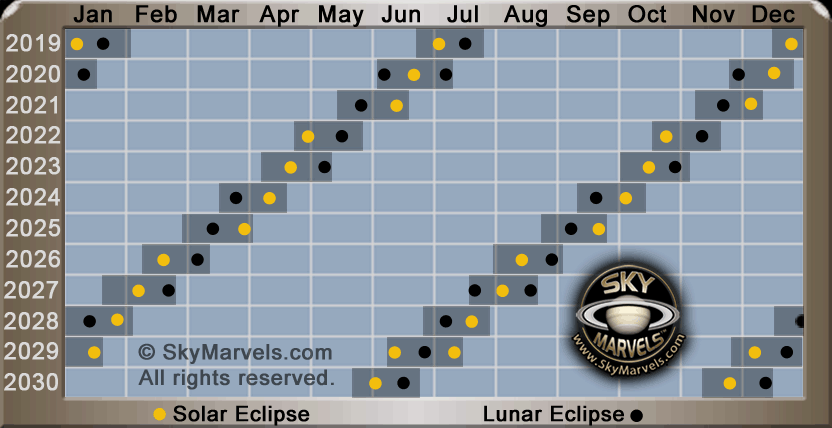
2025 LUNAR ORBIT: VIEW FROM THE SUN (Interactive)
Image Credits: NASA/JPL Solar System Simulator developed by: David Seal. (To update, reload page.)
L O A D I N G 
Phase We
See From Earth
L O A D I N G . . .




Hover near Earth to ZOOM IN.
You are viewing "CURRENT HOUR'S" circumstances.
The Moon's constantly changing circumstances throughout 2025 can be examined easily with this interactive "View from the Sun" tool, which displays Earth, the Moon and the lunar orbit in their proper relative scale and orientation. Step forward and backward in time to view the lunar orbit, phase and distance (in Earth equatorial diameters) at
any hour on any day of the year. Be patient. "View from the Sun" uses the NASA/JPL Solar System Simulator to plot the Moon's orbit, and that site can be a bit slow to respond. Still, throughout the year it accurately shows the Moon's position in its orbit, and how that orbit appears to continually "wobble" around Earth! Moreover it reveals whether—and by how much—the Moon is above or below Earth's orbital plane, the Ecliptic. This makes it easy to see that eclipses do not occur every month because the Moon is usually too high or low relative to Earth's orbit!
A single click shows you how much and in what direction the Moon moves in 1 or 6 hours, or in 1, 3, 7 or 30 days— rounding to the middle of the hour you have chosen to view. You'll soon confirm that the Moon moves roughly a quarter of the way around Earth each week! Discover when the Moon moves up and down through the Ecliptic at its orbit's respective ascending and descending nodes! AstroPixels.com's excellent 2025 Sky Events Almanac gives the times of the Moon's nodal passages, as well as the times of lunar phases and other lunar phenomena that you can examine above. Additionally, you can compare what you discover on various dates above with the Moon's Current Phase and Libration. What's more, when you hover near Earth in the wide view to ZOOM IN, you will see not only our home planet's orientation for the time you are viewing, but also better views of the Moon if it is near a New or Full phase. As you've probably already surmised, this is a particular bonus near the times of eclipses.
 As eclipse seasons approach, you can watch the oval of the lunar orbit as it appears to become thinner and thinner. Solar eclipses that occur when the Moon's orbit still appears to be a very thin oval are visible in Earth's more polar regions. But solar eclipses that occur when the orbit has thinned to a straight line "cut across" the center of Earth—and they can be spectacular! During lunar eclipses, of course, you will see the Moon pass behind Earth, though NASA's Solar System Simulator does not display eclipse shadows.
As eclipse seasons approach, you can watch the oval of the lunar orbit as it appears to become thinner and thinner. Solar eclipses that occur when the Moon's orbit still appears to be a very thin oval are visible in Earth's more polar regions. But solar eclipses that occur when the orbit has thinned to a straight line "cut across" the center of Earth—and they can be spectacular! During lunar eclipses, of course, you will see the Moon pass behind Earth, though NASA's Solar System Simulator does not display eclipse shadows.
Viewed from the Sun, two or three times a year the lunar orbit resolves into a line with a tilt of 5.145° (the tilt of the lunar orbit relative to the Ecliptic)! At such times, the Moon's orbital plane is being seen "edge-on", and the lunar orbit's Line of Nodes is pointing essentially from Earth toward the Sun. It doesn't stay that way for long. From the vantage point of the Sun, the shape of the lunar orbit appears to change constantly, as Earth proceeds in its own orbit and "drags" the Moon along with it. This is why you will see the lunar orbit "wobble" around Earth over the course of a year. In addition, perturbed by other factors that add "less frequent wobbles", the Moon's path itself is highly complex and irregular! You can use this Lunar Perigee and Apogee Calculator for further insight about what you are observing on different dates! Occasionally you will even see the orbits of other planets in the wide view above, as Earth and the Moon appear to pass them from the vantage point of the Sun.
Note that the wide view above is centered "NOT on Earth" but instead on the Earth-Moon Barycenter! This means that, when you ZOOM IN while viewing different dates and times, you will see Earth appropriately displaced to the left or right (even very slightly up and down!) Look closely! This is a striking visual confirmation of our planet's monthly orbit around its and the Moon's common center of mass! Naturally the greatest left or right displacement will be exhibited at First or Last Quarter Moons, when Earth and the Moon "appear" farthest apart from the Sun's vantage point. Conversely, this displacement will be smallest at New and Full Moons. The view below is a quick reminder of the general position of the Earth-Moon barycenter, which is always in motion roughly 1,700 kilometers below Earth's surface.
Notes: Phase views generated by NASA SVS Phase and Libration tool.
NASA/JPL Simulator Fields of View are measured horizontally.
Home Intro News Gallery Sky-Gifts Bonuses Tips
Learning Ctr Help Links Credits Legal Contact Us
© 2007-
by Gary M. Winter. All rights reserved.
Interested in political cartoons and humor?
Check out The HIPPLOMATS™.
SkyMarvels, Sky Marvels, SkyMarvels.com, LUNAR ORBIT: VIEW FROM THE SUN (interactive), View for any day of the year! CURRENT VIEW OF THE MOON'S ORBIT FROM THE SUN, Moon's Orbit, Lunar Orbit, Moon's Phase, Lunar Phase, New Moon, Waxing Crescent, First Quarter Moon, Waxing Gibbous, Full Moon, Waning Gibbous, Last Quarter, Waning Crescent., celestiaforall, CELESTIA, astronomy, space, simulations, animations, downloadable astronomy posters, stars, planets, Inner Planets, Outer Planets, Inferior Planets, Superior Planets, moons, asteroids, comets, Oort Cloud, galaxy, galaxies, Milky Way, Andromeda, globular clusters, binaries, quasars, black holes, supermassive black holes, telescope, telescopes, planetarium, software, freestuff, satellites, add-ons, addons, scripts, eclipses, Solar Eclipses, Lunar Eclipses, Solar Eclipse Finder, Lunar Eclipse Finder, mutual eclipses, transits, occultations, Solar System, CELES-TOOLS, celeSTARrium, CELX, CELX programming, Freebies, multiple views, atronomical unit, light year, parsec, meteors, meteor showers, Perseids, Geminids, Leonids, barycenter, time, Time Zones, tides, alignments, conjunctions, oppositions, seasons, apogees, perigees, aphelion, perihelion, Earth, Luna, Mercury, Venus, Mars, Jupiter, Galilean Moons, Io, Europa, Ganymede, Callisto, Saturn, Titan, rings, Uranus, Neptune, Triton, E-MSpectrum, electromagnetic spectrum, astronaut, equinoxes, solstices, precession, rotation, spin, inclination, tilt, Ecliptic, orbits, ellipse, parabola, hyperbola

